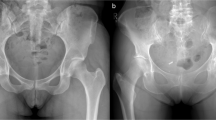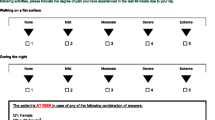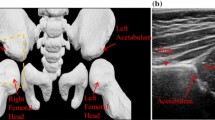Abstract
Objectives
To utilise machine learning, unsupervised clustering and multivariate modelling in order to predict severe early joint space narrowing (JSN) from anatomical hip parameters while identifying factors related to joint space width (JSW) in dysplastic and non-dysplastic hips.
Methods
A total of 507 hip CT examinations of patients 20–55 years old were retrospectively examined, and JSW, center-edge (CE) angle, alpha angle, anterior acetabular sector angle (AASA), and neck-shaft angle (NSA) were recorded. Dysplasia and severe JSN were defined with CE angle < 25o and JSW< 2 mm, respectively. A random forest classifier was developed to predict severe JSN based on anatomical and demographical data. Multivariate linear regression and two-step unsupervised clustering were performed to identify factors linked to JSW.
Results
In dysplastic hips, lateral or anterior undercoverage alone was not correlated to JSN. AASA (p < 0.005) and CE angle (p < 0.032) were the only factors significantly correlated with JSN in dysplastic hips. In non-dysplastic hips, JSW was inversely correlated to CE angle, AASA, and age and positively correlated to NSA (p < 0.001). A random forest classifier predicted severe JSN (AUC 69.9%, 95%CI 47.9–91.8%). TwoStep cluster modelling identified two distinct patient clusters one with low and one with normal JSW and different anatomical characteristics.
Conclusion
Machine learning predicted severe JSN and identified population characteristics related to normal and abnormal joint space width. Dysplasia in one plane was found to be insufficient to cause JSN, highlighting the need for hip anatomy assessment on multiple planes.
Key Points
• Neither anterior nor lateral acetabular dysplasia was sufficient to independently reduce joint space width in a multivariate linear regression model of dysplastic hips.
• A random forest classifier was developed based on measurements and demographic parameters from 507 hip joints, achieving an area under the curve of 69.9% in the external validation set, in predicting severe joint space narrowing based on anatomical hip parameters and age.
• Unsupervised TwoStep cluster analysis revealed two distinct population groups, one with low and one with normal joint space width, characterised by differences in hip morphology





Similar content being viewed by others
Abbreviations
- AASA:
-
Anterior acetabular sector angle
- AUC:
-
Area under the curve
- CE angle:
-
Center-edge angle
- DDH:
-
Developmental dysplasia of the hip
- FAI:
-
Femoroacetabular impingement
- JSN:
-
Joint space narrowing
- JSW:
-
Joint space width
- MLR:
-
Multivariate linear regression
- NSA:
-
Neck–shaft angle
- OA:
-
Osteoarthritis
- α:
-
Alpha angle
References
Wyles CC, Heidenreich MJ, Jeng J et al (2017) The John Charnley award: redefining the natural history of osteoarthritis in patients with hip dysplasia and impingement. Clin Orthop Relat Res 475:336–350
Jacobsen S, Sonne-Holm S (2005) Hip dysplasia: a significant risk factor for the development of hip osteoarthritis. A cross-sectional survey. Rheumatology 44:211–218
Mimura T, Mori K, Kitagawa M et al (2017) Multiplanar evaluation of radiological findings associated with acetabular dysplasia and investigation of its prevalence in an Asian population: a CT-based study. BMC Musculoskelet Disord 18:1–8
Reijman M, Hazes JMW, Pols HAP et al (2005) Acetabular dysplasia predicts incident osteoarthritis of the hip: the Rotterdam study. Arthritis Rheum 52:787–793
Morita D, Hasegawa Y, Seki T et al (2018) A possible new radiographic predictor of progression of osteoarthritis in developmental dysplasia of the hip: the center gap. Clin Orthop Relat Res 476:2157–2166
Morvan J, Bouttier R, Mazieres B et al (2013) Relationship between hip dysplasia, pain, and osteoarthritis in a cohort of patients with hip symptoms. J Rheumatol 40:1583–1589
Stelzeneder D, Mamisch TC, Kress I et al (2012) Patterns of joint damage seen on MRI in early hip osteoarthritis due to structural hip deformities. Osteoarthritis Cartilage 20:661–669
Agricola R, Heijboer MP, Bierma-Zeinstra SMA et al (2013) Cam impingement causes osteoarthritis of the hip: a nationwide prospective cohort study (CHECK). Ann Rheum Dis 72:918–923
Kim Y-J, Jaramillo D, Millis MB et al (2003) Assessment of early osteoarthritis in hip dysplasia with delayed gadolinium-enhanced magnetic resonace imaging of cartilage. J Bone J Surg Am 85A:1–6
Sugano N, Noble PC, Kamaric E, Salama JK, Ochi T, Tullos HS (1998) The morphology of the femur indevelopmental dysplasia of the hip. J Bone Joint Surg Br 80-B:711–719
Mongan J, Moy L, Kahn CE (2020) Checklist for Artificial Intelligence and Medical Imaging (CLAIM): a guide for authors and reviewers. Radiol Artif Intell 2:e200029
Hasegawa Y, Kanoh T, Seki T et al (2010) Joint space wider than 2 mm is essential for an eccentric rotational acetabular osteotomy for adult hip dysplasia. J Orthop Sci 15:620–625
Turck N, Vutskits L, Sanchez-Pena P et al (2011) pROC: an open-source package for R and S+ to analyze and compare ROC curves. BMC Bioinform 8:12–77
Hirvasniemi J, Gielis WP, Arbabi S et al (2019) Bone texture analysis for prediction of incident radiographic hip osteoarthritis using machine learning: data from the Cohort Hip and Cohort Knee (CHECK) study. Osteoarthritis Cartilage 27:906–914
Du Y, Almajalid R, Shan J, Zhang M (2018) A novel method to predict knee osteoarthritis progression on MRI using machine learning methods. IEEE Trans Nanobioscience 17:228–236
Ashinsky BG, Bouhrara M, Coletta CE et al (2017) Predicting early symptomatic osteoarthritis in the human knee using machine learning classification of magnetic resonance images from the osteoarthritis initiative. J Orthop Res 35:2243–2250
Thomas KA, Kidziński Ł, Halilaj E et al (2020) Automated classification of radiographic knee osteoarthritis severity using deep neural networks. Radiol Artif Intell 2:e190065
Gyftopoulos S, Lin D, Knoll F et al (2019) Artificial intelligence in musculoskeletal imaging: current status and future directions. AJR Am J Roentgenol 213:506–513
Anda S, Terjesen T, Kvistad KA, Svenningsen S (1991) Acetabular angles and femoral anteversion in dysplastic hips in adults: CT investigation. J Comput Assist Tomogr 15:115–120
Ito H, Matsuno T, Hirayama T et al (2009) Three-dimensional computed tomography analysis of non-osteoarthritic adult acetabular dysplasia. Skeletal Radiol 38:131–139
Nicholls AS, Kiran A, Pollard TCB et al (2011) The association between hip morphology parameters and nineteen-year risk of end-stage osteoarthritis of the hip: a nested case-control study. Arthritis Rheum 63:3392–3400
Zhang C, Li L, Forster BB et al (2015) Femoroacetabular impingement and osteoarthritis of the hip. Can Fam Physician 61:1055–1060
Hartofilakidis G, Bardakos NV, Babis GC, Georgiades G (2011) An examination of the association between different morphotypes of femoroacetabular impingement in asymptomatic subjects and the development of osteoarthritis of the hip. J Bone J Surg Br 93 B:580–586
Teirlinck CH, Dorleijn DMJ, Bos PK et al (2019) Prognostic factors for progression of osteoarthritis of the hip: a systematic review. Arthritis Res Ther 21:1–19
Bessa FS, Williams BT, Polce EM et al (2020) No differences in hip joint space measurements between weightbearing or supine anteroposterior pelvic radiographs. Arthroscopy 36:2843–2848
Lange AE, Lange J, Ittermann T et al (2017) Population-based study of the incidence of congenital hip dysplasia in preterm infants from the Survey of Neonates in Pomerania (SNiP). BMC Pediatr 17:78
Acknowledgements
The authors would like to thank Prof. Joseph O’Beirne, University Hospital Waterford, Ireland, founding member of ICODE (http://www.icode.expert/), for his valuable comments.
Funding
The authors state that this work has not received any funding.
Author information
Authors and Affiliations
Corresponding author
Ethics declarations
Guarantor
The scientific guarantor of this publication is Prof. Apostolos Karantanas.
Conflict of interest
The authors of this manuscript declare no relationships with any companies whose products or services may be related to the subject matter of the article.
Statistics and biometry
One of the authors has significant statistical expertise.
Informed consent
Written informed consent was obtained from all subjects (patients) in this study.
Ethical approval
Institutional Review Board approval was obtained.
Methodology
• retrospective
• cross-sectional study
• multicenter study
Additional information
Publisher’s note
Springer Nature remains neutral with regard to jurisdictional claims in published maps and institutional affiliations.
Supplementary information
ESM 1
(DOCX 447 kb)
Rights and permissions
About this article
Cite this article
Klontzas, M.E., Volitakis, E., Aydingöz, Ü. et al. Machine learning identifies factors related to early joint space narrowing in dysplastic and non-dysplastic hips. Eur Radiol 32, 542–550 (2022). https://doi.org/10.1007/s00330-021-08070-x
Received:
Revised:
Accepted:
Published:
Issue Date:
DOI: https://doi.org/10.1007/s00330-021-08070-x




